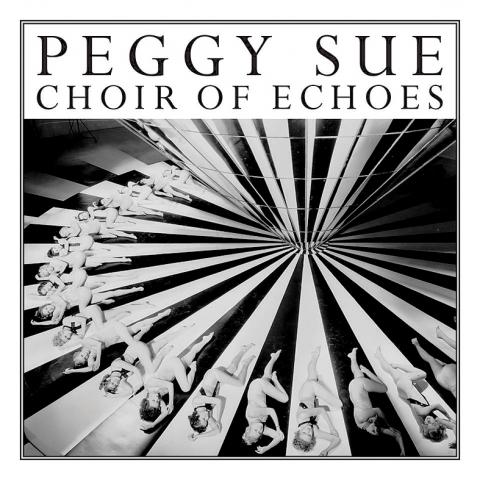Too True, by Dum Dum Girls
Dum Dum Girls, based in New York, and Peggy Sue, a British band, started in different realms: punky for Dum Dum Girls, folky for Peggy Sue. But there are moments on their two new albums when they are making nearly the same music, with women’s voices, a galloping beat and a guitar swathed in reverb.
Dum Dum Girls found that sound first. The group — which is now, in its studio lineup, just songwriter, singer and guitarist Dee Dee, abetted by guitarist, drummer and programmer Sune Rose Wagner, from the Raveonettes — arrived in 2008 with a concept so fully formed that, as with the Ramones, each successive album has largely offered refinements and variations.

“There’s no particular place we are going/Still we are going,” Dee Dee sings in Lost Boys and Girls Club on the new Dum Dum Girls album, Too True.
Dum Dum Girls continue to explore a sonic and formal intersection of the early 1960s — girl groups, surf-rock, garage-rock — and the post-punk 1980s of the Jesus and Mary Chain and My Bloody Valentine. A few chords, a clear melody and succinct verse-chorus-bridge structures are filled with darkly allusive lyrics and floated amid gauzy, sweeping guitar effects.
It’s a roomy concept, encompassing spaghetti Western guitar touches in Cult of Love, new wave momentum in Little Minx, stately folk-rock in Under These Hands, a weighty undertow in Lost Boys and Girls Club and a celestial serenity in Trouble Is My Name. As the titles suggest, Dee Dee’s lyrics glimpse loss, betrayal, loneliness and death, but she sings them calmly, in productions so finely burnished that the sound washes away the sadness.

Peggy Sue is a newer convert to the glories of reverb. The group is a trio, with Rosa Slade and Katy Young on vocals and guitars, and Olly Joyce on drums, and its songs can sound simultaneously old and new. The guitar-picking patterns and stark, open vocal harmonies have Celtic roots; the beat, the words and the way songs gather more intertwined parts as they go mark them as rock. Peggy Sue has grown more plugged in with each album, and Choir of Echoes revels in electric guitar tones, using reverb to add spookier depths. Substitute, with a tom-tom beat, a tambourine, a repetitive two-chord riff and the squeak of fingers on reverbed guitar strings, could be a rawer early Dum Dum Girls song.
The lyrics are full of love gone wrong: regrets, misunderstandings, reconciliations and more regrets. “I forget all the errors of your ways,” the women sing, “But I remember now.” Guitars intertwine and gather around them, in ever-thickening skeins of picking and strumming, pulling a listener into all the mesmerizing turbulence of those troubled romances.
— Jon Pareles, NY Times News Service

Anthem for a New Day, by Helen Sung
Jazz musicians do a lot of their growing up in public — it’s one consequence of a field in which talent shows up sooner than artistry — and the process usually follows a model of judicious refinement. But that’s not quite the case with Helen Sung, who trained as a classical pianist before turning to jazz, and has released a decade’s worth of crisp, conscientious and decorous albums. Anthem for a New Day is her major-label debut, and she has described it herself as a leap forward, the first full measure of her identity.
That’s a convenient selling point, but the music readily supports it. Clarity of purpose has never been a problem for Sung, whose previous albums include a bundle of themes inspired by Catalan composer Isaac Albeniz. And the quality of her touch, like her grasp of harmony and form, has never been in doubt. What’s striking this time around is an openness of vision, paired with a looseness of execution. Sung sounds both relaxed and searching, and she imparts the same qualities to her crew.
Those players represent a contemporary index of post-bop accomplishment. Her front line features Seamus Blake on tenor and soprano saxophone and Ingrid Jensen on trumpet; her rhythm section has bassist Reuben Rogers, drummer Obed Calvaire and percussionist Samuel Torres. Among the special guests are violinist Regina Carter and clarinetist Paquito D’Rivera.
Sung has neatly finessed her share of jazz standards, so it’s instructive to hear the liberties she takes with Thelonious Monk’s Epistrophy and Duke Ellington’s It Don’t Mean a Thing (if It Ain’t Got That Swing), bringing an elasticity and swagger to both. (She’s more faithful, to a fault, with the Chick Corea tune Armando’s Rhumba.)
Her originals deliver on a promise of buoyant lyricism (Hope Springs Eternally), scrambling intensity (Chaos Theory) and brisk textural intrigue (Hidden and the title track). Brother Thelonious — commissioned by North Coast Brewing Co, which has a Belgian-style ale by that name — suggests a Monkish idyll as envisioned by Art Blakey’s Jazz Messengers, sometime in the 1980s.
Sung plays some of these on a Fender Rhodes, which brings a softer dimension to her sound. But she’s alone at an acoustic piano on Equipoise, a Stanley Cowell composition that closes the album on a note of muted reflection. Her reading of the piece glows with subtlety: She makes it feel like the serenest sort of mission statement.
— Nate Chinen, NY Times News Service

April 14 to April 20 In March 1947, Sising Katadrepan urged the government to drop the “high mountain people” (高山族) designation for Indigenous Taiwanese and refer to them as “Taiwan people” (台灣族). He considered the term derogatory, arguing that it made them sound like animals. The Taiwan Provincial Government agreed to stop using the term, stating that Indigenous Taiwanese suffered all sorts of discrimination and oppression under the Japanese and were forced to live in the mountains as outsiders to society. Now, under the new regime, they would be seen as equals, thus they should be henceforth

With over 100 works on display, this is Louise Bourgeois’ first solo show in Taiwan. Visitors are invited to traverse her world of love and hate, vengeance and acceptance, trauma and reconciliation. Dominating the entrance, the nine-foot-tall Crouching Spider (2003) greets visitors. The creature looms behind the glass facade, symbolic protector and gatekeeper to the intimate journey ahead. Bourgeois, best known for her giant spider sculptures, is one of the most influential artist of the twentieth century. Blending vulnerability and defiance through themes of sexuality, trauma and identity, her work reshaped the landscape of contemporary art with fearless honesty. “People are influenced by

Last week, the the National Immigration Agency (NIA) told the legislature that more than 10,000 naturalized Taiwanese citizens from the People’s Republic of China (PRC) risked having their citizenship revoked if they failed to provide proof that they had renounced their Chinese household registration within the next three months. Renunciation is required under the Act Governing Relations Between the People of the Taiwan Area and the Mainland Area (臺灣地區與大陸地區人民關係條例), as amended in 2004, though it was only a legal requirement after 2000. Prior to that, it had been only an administrative requirement since the Nationality Act (國籍法) was established in

The remains of this Japanese-era trail designed to protect the camphor industry make for a scenic day-hike, a fascinating overnight hike or a challenging multi-day adventure Maolin District (茂林) in Kaohsiung is well known for beautiful roadside scenery, waterfalls, the annual butterfly migration and indigenous culture. A lesser known but worthwhile destination here lies along the very top of the valley: the Liugui Security Path (六龜警備道). This relic of the Japanese era once isolated the Maolin valley from the outside world but now serves to draw tourists in. The path originally ran for about 50km, but not all of this trail is still easily walkable. The nicest section for a simple day hike is the heavily trafficked southern section above Maolin and Wanshan (萬山) villages. Remains of